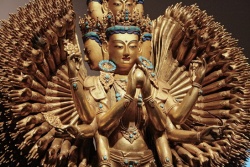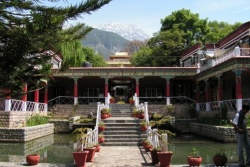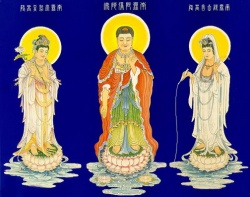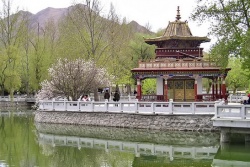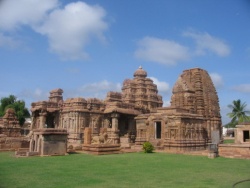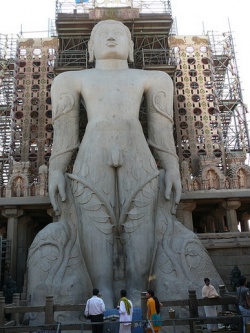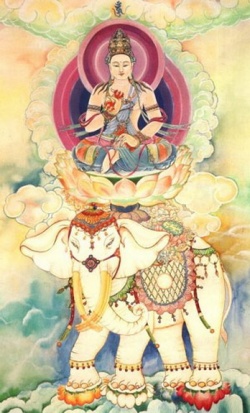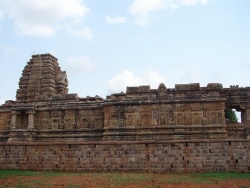The Tantric Rite of the Ganacakra-puja
The Antiquity of Sacramental Ritual
With the great cultures of our past, the Sumerian, Chaldean, Egyptian, Hellenic, and the Indian, a chief place in the human drama of spiritual devotion belonged to the celebration of sacramental Mysteries. As generation succeeded generation in the cycle of human affairs, the hieratic wisdom of the Ancients was successively transplanted into each newly dawning cultural milieu. From the secret schools of Tantra in India, it was transplanted to the Lamaist colleges of Tibet. And so, from common roots now barely discernable in the archeological rubble of civilizations long gone, there has been transmitted to us today a universal sacramental archaic inheritance in the form of the Tantric Rite of the Ganacakra-puja.
There is now evidence of an original eucharistic feast having been performed in neolithic Anatolia. The best known of the Anatolian sites is Catal Huyuk, excavated in 1960 by Mellaart. This complex town was a high ceremonial center. Its age is estimated from c. 7000 to c. 6500 B.C.
The people of Catal Huyuk "were peaceful agriculturalists, mostly vegetarians," says Sjoo and Mor (The Great Cosmic Mother, NY 1987). "Twelve successive layers have been excavated, and no signs of warfare or weaponry have been found. There are also no signs of animal slaughter within the town..." And Erich Fromm, in The Anatomy of Human Destructiveness, speculates that: "The fact, however, that these neolithic villages in Anatolia had a matriarchal (matricentric) structure, adds a great deal more evidence to the hypothesis that neolithic society, at least in Anatolia, was an essentially un-aggressive and peaceful society."
The sacramental Mysteries were fundamental for the Middle Eastern Magi, whose secrets we believe to have been transferred on the one hand to the early Greco-Roman pagan cults, and on the other to the Jewish Therapeutae, Essenes and Nazarenes of Israel and Egypt. Those same Mysteries were transmitted via apostolic succession in the early schools of [[Wikipedia:Christianity|Christianity]], both gnostic and orthodox. From the Middle East, the esoteric stream, continued by the priest-sages of Zervan Akerene, affected the teachings of Mani, and entered Shamballah in northern Afghanistan and neighbouring Uddiyana in Pakistan. It is through the seventh and eighth century initiates of Uddiyana that our sacred Rites come down, in unbroken succession, to the present day.
The Russian mystics, Prince Yuri Ukhtomsky and G.I. Gurdjieff, believed that, hidden amidst the rites of the ancient Mysteries, there lay a profound knowledge, which has been overlooked by modern man. Bennett (vide Gurdjieff, A Uery Great Enigma) tells us that: "Before [[Wikipedia:Christianity|Christianity]] came, Cappadocia was a center of the cult of Anahita, the Mother Goddess.... with her (that is, with her priests/priestesses) there came a great body of knowledge, and some of that knowledge, perhaps more than people can readily appreciate, has been brought into the construction of the Christian liturgy. One could say much about the mystery of this liturgy, which contains so much knowledge, so many hidden things; for this deeply impressed Gurdjieff, and he wanted to understand what was being preserved for mankind behind the ritual of the liturgy."
Searching for sources of this knowledge, Gurdjieff (vide Meetings with Remarkable Men, NY 1974) uncovered some lost manuscripts in Armenia which referred to a so called 'Sarmoung Brotherhood' whose beginnings were, according to tradition, "founded in Babylon as far back as 2500 B.C., and which was known to have existed somewhere in Mesopotamia up to the sixth or seventh century A.D. [i.e., up until the Moslem invasion]." He was eventually to locate a survival of this brotherhood at Garam Chasma, on the Lotkho river, in the region of the Chitral.
Later in his life Gurdjieff was to declare,
"The Great Knowledge is handed on in succession from age to age, from people to people, from race to race. The great centers of initiation in India, Assyria, Egypt, Greece, illumine the world with a bright light. The revered names of the great initiates, the living bearers of the truth, are handed on reverently from generation to generation. Truth is fixed by means of symbolical writings and legends and is transmitted to the mass of people for preservation in the form of customs and ceremonies, in oral traditions, in memorials, in sacred art through the invisible quality in dance, music, sculpture and various rituals. It is communicated openly after a definite trial to those who seek it and is preserved by oral transmission in the chain of those who know. After a certain time has elapsed, the centers of initiation die out one after another, and the ancient knowledge departs through underground channels into the deep... From time to time separate streams break through to the surface, showing that somewhere deep down in the interior, even in our day, there flows the powerful ancient stream of the true knowledge of being." (Vide: Gurdjieff, Views from the Real World, button, NY 1973).
Undoubtedly, too, David Reigle is correct when, in his study of The Books of Kiu-te, he similarly points out that:
"The Mystery Schools long ago began to disappear in Egypt and Greece, and eventually even in India, until finally Tibet became the last place on the globe in which they could exist with public recognition. There they remained a goal set before the people, which could be reached by following the long and demanding course of training given in the monasteries.... These were the Tantric Colleges of Tibet, wherein the Books of Kiu-te (rgyud-sde) formed the curriculum." (D. Reigle, The Books of Kiu-te, Wizards Bookshelf, San Diego 1983).
What all of this points to, is the great and wondrous importance that the sacramental Mysteries have played in the lives of the world's mystics throughout the millennia. Why this should be so, is easy enough to fathom. Amongst all mammalian life, from the moment of birth, food truly becomes a link with the warmth and love of the mother. Food becomes the very transmitter of love. Therefore the offering (puja) of food is primal, instinctual and archetypal, and when as a vehicle of love it is offered in the highest spiritual sense, its transubstantiation into a means of grace becomes a sacred play of the highest possible order.
What is more, where food as a sacrament is treated with awe and veneration, we would expect the ikon of Divinity to include attributes of motherhood. And indeed this is the case in ancient times. In the sacramental Mystery Schools of ancient Sumeria and Babylon the attributes of Divinity were originally feminine. Mother-love, sacramental food, the mystery of sex and birth, belief that the cosmos is governed by natural law (dharma) rather than a ruling deity (isvara), and a transcendental path of spiritual awakening - these in particular are some of the chief characteristics of what is known as the Ancient Wisdom, and later as Yoga Tantra. Dr. N. Bhattacharya, in his scholarly History of the Tantric Religion, notes: "...that mother-right elements in India are stronger, both in extent and in degree, than those in any other part of the world. . . These are revealed in the survivals of social customs and institutions like matrilineal descent and inheritance, matrilocal marriage and residence, and other allied features so common in Indian tribal life, the cults and rituals of the Mother Goddess, and a female-oriented world view manifested in....the tantric forms of religious systems. In the field of the tantric forms of religious systems matriarchal influence was so deep-rooted that in South-East Asia even priests of the Tantric cults followed a matrilineal system of succession. . . These are all vestiges of a primitive way of life."
Furthermore, it is profoundly significant that, in each school were the Sacramental Mysteries can be traced; the form of the sacraments is invariably the same. There, always, we have the central eucharist (Skt: Balingta, Tib: Tor-ma) and the two cruets containing the 'red' and 'white' ambrosias. With yesterdays Mazdeans or today's Christians, with ancient Gnostics or modern Tantrics, although continents apart and undoubtedly separated by grave differences of theological outlook, the core of sacramental and liturgical performance differs hardly at all. This in itself is sufficient to suggest a common origin for a mystery revealed to humanity in the deep past.
Some will indeed be shocked to see in our translation of the Holy Liturgy of the Ganacakra-puja a close parallel with the sacred Mass of the apostolic Churches of great [[Wikipedia:Christianity|Christianity]]. But as His Holiness Tenzin Gyamtso the XIV Dalai Lama of Tibet has said: "Christians and Buddhists have basically the same teachings and the same aim." No where is this more evident than in our common sharing of similar Sacramental Mysteries.
The Holy Liturgy of the Ganacakra-puja is a sacred rite, with hallowed antecedents, going back at least five millennia, which we have preserved in its purest form. It is a rite which we approach in a state of spiritual awe and wonder, seeking within it's mystery a gateway to personal transformation. Indeed, sacramental action is after all entirely personal; it is the means whereby grace is appropriated to each participant individually. In the sacrament of the eucharist (balingta) the Tantrika takes material substance - flour, water, oil, wine, etc. - and imparts to that the potential for transmitting divine grace. Thus, the initiate inaugurates in ritual something which heralds the redemption of matter itself, the transfiguration (Skt: maha-samkranti) of the body through Divinization, when what is corruptible is made purely incorruptible.
Abhorrence of Sacrifice in the Buddhist Rite
It must be appreciated that in the West certain aspects of the dogma of transformation or transubstantiation (the Greek word is metousiosis, 'change of essence') now held by Christian theologians is at variance with ancient Buddhist orthodoxy. According to the present day Christian Rite the central action is sacrificial; indeed, what is called "the Mass" is apparently a simulated human sacrifice. This view is supported by the belief that the crucifixion itself was a sacrifice. For example, Orthodox Dogmatic Theology teaches that, "The sacrifice on Golgotha and the sacrifice of the Eucharist are inseparable, comprising a single sacrifice." And according to Bishop Kallistos Ware, "the Eucharist is a propitiatory sacrifice (in Greek, thusia hilastirios), offered on behalf of both the living and the dead." The sacrifice which is offered, says the good bishop, is the sacrifice of Jesus Christ himself.
For the Buddhist the entire concept of sacrifice is abhorrent. Sacrifice belongs to a certain stage in man's primitive past. Sjoo and Mor, in The Great Cosmic Mother (NY 1987), point out that, "Ritual cannibalism doubtless began with shared eating of the totem animal—a taking of the animal's life force by the group; to participate in its death, in its lifeblood, is to partake of its eternal rebirth in the Mother. Where it occurred in the world, ritual cannibalism—like hunting—was predominantly or exclusively a male activity... This sacred cannibalism is still practiced, symbolically, in the Christian communion." Any idea of animal sacrifice, let alone human cannibalism, is shocking to the Buddhist.
It was Cuesta (d. 1560), bishop of Leon, who appears first to have suggested that in the Christian ritual, Christ was slaughtered(mactatur) by the priest. Missa est sacrificium, he declared. And yet Prof. John Dominic Crossan, in The Historical Jesus (Harper, San Francisco 1991), shows clearly that in the original Christian eucharistic ceremony "even when the bread is developed symbolically... that symbolism still has nothing to do with the death of Jesus."
Crossan states that:
"....even late in the first century C.E., at least some Syrian Christians could celebrate a Eucharist of bread and wine with absolutely no hint of...passion symbolism [or sacrifice] built into its origins or development. I cannot believe that they knew all about those elements and studiously avoided them. I can only presume that they were not there... from the beginning, that is, from solemn, formal, and final institution by Jesus himself."
This agrees well with what Jesus is made to say in the apocryphal Gospel of the Nazarenes: "I came to abolish sacrifices, and unless ye cease to offer sacrifices, the wrath of God shall not cease from you." The original mystical eucharist ceremony - its un-perverted pre-Roman form—was no sacrifice (thysia), but purely an 'un-bloodied' feast (deipnon), as it is to this day in the Supreme Yoga Tradition. That true Feast has ever been un-blooded and non-sacrificial, as is shown even in the Old Testament. Abel sacrificed a lamb, immolating it in the fire. Abraham attempted a sacrifice of his own son, and even when his hand was stayed, substituted a ram. But Melchizedek is presented as the 'true priest' who offers no blood sacrifice, but comes to Abraham with the pure sacrament of bread and wine. Melchizedek is he who is 'without father, without mother, without ancestral descent, having neither beginning of days, nor end of life, but a being like unto a beni-Elohim.' (Hebrews 7:3).
Melchizedek, if viewed as an archetypal figure, is remarkably similar in "meaning" to our own Master Padmasambhava, the putative founder of Buddhism in Tibet.
Dr. Milner, Christian bishop and apostolic vicar, points out, "It was then in offering up a sacrifice of bread and wine, instead of slaughtered animals that Melchizedek's sacrifice differed from the generality of those in the Old Law... No other sense than this can be elicited from the Scripture as to this means; and accordingly the holy fathers unanimously adhere to this meaning."
The Magi of Persia were founded by the great teacher Zarathustra, the Sun of Asia. Zahner, in The Dawn and Twilight of Zoroastrianism (NY 1961), informs us that Zarathustra adopted what in his time (c. 600 B.C.) was already an ancient Eucharistic rite.
"So far as we can tell, the Haoma rite has been the central liturgical act of Zoroastrianism ever since that religion developed," says Zahner.
Receiving messianic traditions from the Magi, the Essenes in the wilderness of Judah referred to themselves as a 'New Covenant', and celebrated this covenant, or union between man and God, during a secret ceremony that is known to us as the Messianic Banquet. And in Luke 14:15 Jesus appears to make reference to this as the 'great banquet', which in Matthew 22:2 he calls a marriage feast: "The kingdom of heaven may be compared to a...marriage feast."
Likewise there was a Eucharistic offering in the Eleusinian Mysteries; an offering that was non-sacrificial, after the manner of Melchizedek. The Eleusinian Mysteries were dedicated to Demeter (the Roman name for the great Mother Ceres, from whence our word cereal), in whose honour bread and wine were treated as sacred. Even the term eucharistia originally meant wheat-flour offered to Ceres in the Mysteries. Those who conducted the Mysteries were known as:
the Hierophant, who presided over the ceremonies;
the Priest (Iereus or Dadouchos), who acted as chief assistant to the Hierophant;
and the Deacon (Epibomus), or altar-server, who conducted the censing and offerings. The Mysteries were always introduced by a Hieroceryx ('sacred herald') shouting out, "Begone, begone, O ye profane," for only 'worthy' initiates might be admitted; the impure and unworthy being kept far away.
Yoga Tantra is remarkable for transmitting the same, unaltered tradition. The Rite is considered mystically a Great Secret (mahaguhya). The officers of the Ganacakra Ceremony are three, although individually the celebration can be performed by one practitioner alone. The three officers are:
Hierophant (Skt: Vajracarya, Tib: Dorje Lo-pon), who oversees the rite.
Priest (Skt: Purohit, Tib: Um-dze, lit: 'head-celebrant'), who leads the rite.
Deacon (Skt: Pujari, Tib: Chod-pon), the Puja-master, who assists the priest.
The clergy of Tantric Buddhism are divisible into two broad classes: the 'white' ordained clergy who are married, and the 'red' ordained clergy who are celibate. Therefore the roles of Hierophant, Priest and Deacon may be held equally by married or celibate persons. And there is, in the Buddhist Rite, equality between the sexes also; every role is capable of being held by either a man or a woman.
Secret Origin of the Hieratic Tantric Rite
In 3000 B.C. there arose in southern Mesopotamia an unique, special style of temple, called the Ziggurat; a type of stepped pyramid, having a chapel on the summit and oriented in such a way as to align with certain astronomical configurations. Although in the temples and chapels at ground level which remained close to the Ziggurat there have been found images of gods and goddesses, to satisfy the needs of the common people, in the unique chapel on the summit of the sacred mound, where only initiates could enter, no statues, idols, or anthropomorphic images of any kind, were ever allowed.
The Ziggurat chapel was the sanctum sanctuarium, the holy of holies, the `high place' where only the most sacrosanct of rites were ever enacted: rites so sacred that the profoundest secrecy was maintained concerning them. A hint, however, is revealed by one ancient historian. Herodotus tells us that in the midst of the temple grounds of Babylon, there once stood "a solid tower, of one stade in height, and in length and breadth of the same....on which tower another is built, and a third upon that, till they make up the number eight. The ascent [of this Ziggurat] is made by a circular way, carried round the outside of the building to the summit....and within the uppermost tower a spacious chapel is built, in which an altar of gold forms a magnificent bed. No image is allowed in this place, nor is anyone permitted to remain there by night, so say the Chaldean priests of the Temple, except only a maiden chosen by God out of the whole nation; affirming for a fact; which nevertheless I think incredible, that God comes by night and lies with the lady: which resembles the account given by the Egyptians of their Temple at Thebes."
The enactment to which Herodotus alludes is known as the hierogamos. This 'sacred marriage,' actually mentioned in the Christian Book of Revelations, concluded a year long period of celibate discipline on the part of the priestess, and was consummated only on the grand New Year festival. It is said in Gudea's description of this solemn event that after the completion of the Hierogamos, a sacramental Supper-feast took place wherein the Sovereign and the whole population of the city, united in prayer, shared communion (vide Henri Frankfort, Cylinder Seals, London 1939).
Do we have here the origins of our Tantric eucharistic tradition, with the evidence that it has indeed come down to us from ancient Babylon? Perhaps it is here that we discover our most sacred religious roots.
What is amazing is that this same secret tradition entered primitive 'original' [[Wikipedia:Christianity|Christianity]], introduced as we believe by no less a person than Jesus himself. In the Book of Revelation (Ch.19: 7-9) it is said by one who must have been an Initiate: "Let us rejoice and exult, and give the glory to him, because there came the marriage of the lamb (gamos tou arniou), and his wife prepared herself, that she might be clothed in fine white linen; for fine linen pertains to the Act of Righteousness of the saints. And he tells me: Write thou, 'Blessed are the ones called to the Supper-feast of the Marriage of the Lamb."' That this ritual was mystically enacted we know from a reading of the Gospel. In connection with what is called the last Supper, when Jesus and his disciples were secretly gathered in the Garden (sacred grove) at the foot of the Mount of Olives, there was, says Mark (14:51-52): "a certain 'young man' (neaniskos, a neophyte) with [[[Wikipedia:Jesus|Jesus]]], clothed in a white linen garment over his nakedness...." When the Jerusalem police arrived on the scene, they attempted to seize the young man, "but he fled away, leaving the linen garment behind." Dr. Morton Smith (The Secret Gospel, Wellingborough 1985), who draws a connection between this scene and the symbolic death and resurrection of Lazarus, notes that "through seventeen hundred years of New Testament scholarship, nobody has ever been able to explain what that young man was doing alone with Jesus in such a place, at such a time, and in such a costume."
It was amongst the Sarmoung Brotherhood, at the temple of Houdankr, in the Lotka Valley of the Chitral (northern Pakistan) that the Russian mystic Gurdjieff claimed to have been introduced to the inner mysterium. And Ouspensky notes in his In Search of the Miraculous (NY 1949, p.102), Gurdjieff was taught that,
Every ceremony or rite has a value if it is performed without alteration.... A ceremony is a book in which a great deal is written. Anyone who understands can read it. One rite often contains more than a hundred books.
The point is this: somehow, in an unbroken mystical tradition, the ancient spiritual mystery once understood and celebrated in the ancient temples of the Brotherhood of Light in Babylon and in Egypt by a sacerdotal circle of initiates in possession of divine wisdom, has survived down to the present day. Tantric initiates know perfectly well what the 'young man' robed in white linen was doing in the sacred grove on the Mount of Olives, on the night of the 'last' Supper: the supper-feast of the hierogamos of the Lamb. He was receiving diksha.
In the Yoga Tradition of ancient Bactria and Uddiyana, the 'secret'-the hierogamos and the eucharist-was preserved, without alteration or profanation. This 'Tantric Buddhism' is the Buddhism that was eventually brought to Tibet, and which we are now bringing, from Tibet, to the Americas.
Offering of One's Own Body
Although there is not the slightest concept of sacrificial symbolism associated with the eucharist in Buddhism, there is a profound psychological understanding of the symbolical correspondence between food and the bodily flesh. The psychological link between food and flesh means that when one offers the gifts ceremoniously in a high act of pure devotion, one is making an inner offering of one's own body and blood.
Prof. Jung points out in his study of Transformation Symbolism in the Mass, that the act of gifting "consists in the first place in giving something which belongs to me", and "everything which belongs to me bears the stamp of 'mine-ness', that is, it has a subtle identity with my ego." Thus when Jesus said, 'Hoc est enim corpus meum' and'hic est enim calix sanguinis mei', referring to the bread and wine, he was demonstrating the psychological identity of giver and gift, which he desired his disciples to perform, in remembrance after him. This is precisely the esoteric Tantric doctrine.
In the cryptic Hevajra-dakini-tantra, for example, translating the secret 'coded' symbolism, we read:
With the malatindha (jasmine = madhya, wine) of the covenant, when seated on the tiger's hide, celebrate communion: [offer a] feast of royal-salija (rice = mahamamsa, one's symbolic bodily flesh).
The initiate, understanding the hidden meaning of the words malatindhana and raja-salija, knows that the sacrament of eucharist (balingta) and wine (madhya) symbolically equates with his human body and blood. This is not thought of as the body and blood of a sacrificial victim, either man or god. Rather, it is an "un-blooded" offering of one's own substance and spirit.
As the offering is a pure gift, it becomes the outer expression of an inner grace. Thus, through the Holy Liturgy, the participant becomes a recipient of a shower of grace-waves (Skt: adhisthana). In the sacramental mystery the practitioner acquires miraculous accomplishment (siddhi), perhaps even the fulfillment of the spiritual path.
On the psychological level this is in itself an act of health. "Those who are essentially 'takers', who give nothing in return either spiritually, emotionally or practically," suggests M. Hope (vide: The Psychology of Ritual, Element Books, Shaftesbury 1988), are more inclined to neurosis and psychosis.... Thus, many of the ancient pantheistic and animalistic rites, both collective and personal, which involve the act of giving out before one takes in, could alleviate some of the suffering and tension of modern-day living and engender a respect for and a need to communicate with the eco-environment by rendering a clearer comprehension of the life force in all things."
That one receives back what one first gives is emphasized in the Tantra, where we read: "Presenting a sacred chalice (kapala) filled with wine, the good devotee should offer it to the Guruji; then having made obeisance, he himself should consume it."
Conclusion
Those who attend a Ganacakra Ceremony come bringing gifts. That is, they bring food and drink for the feast; flowers, incense and candles for the altar; money for the support of the Community and the Clergy. These gifts should, like the giver, be pure. The food should be clean, the flowers should be fresh, the candles should not have been previously used, and the money should not have been acquired by immoral means.
To perform the Holy Liturgy is to enter a mandala, a sphere of sacred space. During the rite the ordinary mind and the habits of worldly life are brought into touch, momentarily, with a higher dimension of spiritual meaning, from whence blessings flow into one's personal being. These blessings gradually transform body, speech and mind.
When we perform this Sacred Ceremony we do so with great awe, dignity, love and devotion. The blessed Jigme Lingpa, one of the greatest saints in our tradition, said that the Puja is only performed properly if it causes us to weep tears of emotion. If we truly give ourselves to the Ceremony in the manner suggested by Jigme Lingpa, we shall indeed be absorbed into profound Contemplation (samadhi), and receive the bliss of the saints.
Comments on the English-language Pecha Text of the Ganacakrapuja in usage by the Dharma Fellowship, by a member of the Dharma Fellowship.
Besides contributing to the development of an English language translation for the Ganacakra-puja ceremony, as American Buddhists we applaud the Dharma Fellowship every step along the way in its effort to interpret the Holy Liturgy of the Tantric Mysteries in a manner where in, it is hoped, the modern Western devotee can find contemporary meaning and inspiration. His Holiness the 16th Karmapa asked us to not only translate the Dharma into English, but also to "translate" Tibetan Buddhism into an authentic American Buddhism. Of course, this means to do so, without falsifying or changing the proper intent of the teachings.
The official language of the Sangha of the Four Quarters (i.e., the ancient Universal Buddhist Church) has always been and of course always remains the 'language of the people,' as established by law in the Vinaya. When the two Brahmin-born monks Yamelu and Tekula asked the Blessed Master to place the Dharma in the scriptural Sanskrit language of the metrical Vedas, the Lord rebuked them, saying: "Whoever should establish it thus, performs an offence of wrong-doing." He stipulated, "I authorize, O monks, that you shall learn the speech of the Buddha each according to his own language" (Vide Cullavagga V, p. 193 PTS). Likewise when on another occasion some monks wished to sing the Dharma in a long-drawn melodious chant, the Lord stopped them. "Monks," he said, "there are these five disadvantages to one singing dharma in a long-drawn melodious chant: he who does so is pleased with himself in regard to his singing; others then become enamoured of that singing; the laity [who consequently will not be able to follow the words] will be displeased; and because he strives for accuracy in the notes of the sound there will occur an interruption in his mystical concentration; and finally, succeeding generations of followers will fall into false views." What the Blessed One allowed was short plain chant, or recitation. "Monks," he said, "I allow plain chanting (sarabhanna)." (Vide Cullavagga V, p.146) Thus, just as the Tibetan peoples translated every word of Dharma into their own language from the Indian tongue, so is it now commendable to transfer that which we inherit from the Orient into our native speech. Indeed, insofar as the great majority of our community in the United States belongs to a first or second generation of American Buddhists whose language is English, and who are not conversant in either Oriental script or speech, an authorized translation of the Holy Liturgy is an imperative and unquestionable necessity.
Since the Ganacakra-puja, or offering of the Eucharist, is a central act of worship in Supreme Yoga Tantra and the Holy Liturgy its vocal means, we pray that the English translation of this text may serve as a guide to the faithful of our Community on the spiritual path of Enlightenment, instilling in all practitioners the devotional virtues of self-surrender, purity of heart and ardent mystical love. And we likewise pray that its enactment may awaken their understanding that they may accomplish the bliss and true liberation granted through refuge in the Lord Absolute, the Truth, and the One Holy Buddhist Community.
